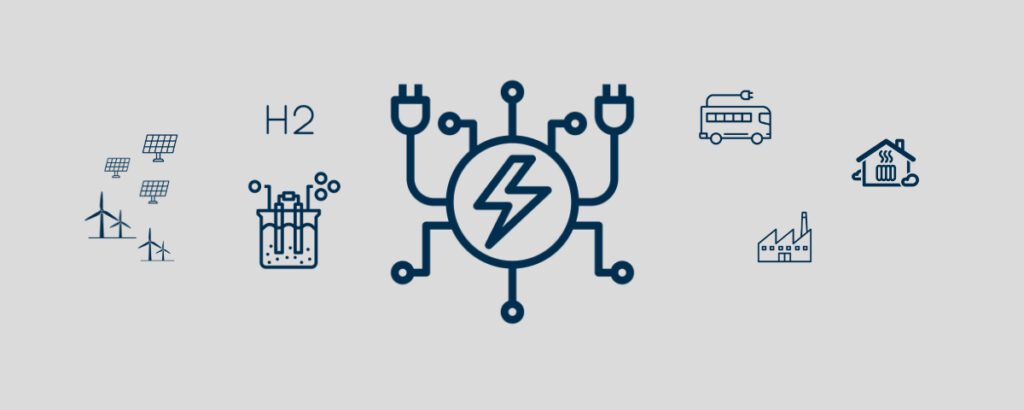New study shows how green hydrogen can be used sensibly through flexible production
October 18th, 2023 | Hydrogen should be produced primarily when a lot of green electricity is available in order to avoid additional CO2 emissions in the electricity system. H2 quantities produced in this way can be used flexibly over time in sensible areas of application. A consistent expansion of renewable energies is crucial for a climate-friendly production of green hydrogen. These are the findings of a recent study by the Reiner Lemoine Institute on behalf of the eco-energy cooperative Green Planet Energy.
Green hydrogen is a central building block of the energy transition. It can be used as a raw material and fuel instead of carbon-containing fossil energy sources such as coal or natural gas. The results of the study show that steel production and air traffic, for example, are among the areas where it could be used in the future, because there is a lack of sustainable alternatives to replace them. To achieve the German government’s climate targets, these areas should be decarbonized as far as possible, i.e. freed from their dependence on carbon-based energy sources. Green hydrogen can be produced in a particularly climate-friendly way if the electrolysers required for production are used as flexibly as possible.
A flexible mode of operation for electrolysers means that they produce hydrogen in particular when there is a particularly large amount of inexpensive green electricity available in the grid. With inflexible operation, on the other hand, electrolysers run for as many hours as possible in the year. Due to the high proportion of fossil fuels in the German electricity mix to date, many emissions are produced in the overall electricity system.
The results of the study show how emissions can be avoided in the production of hydrogen. The rapid expansion of renewable energies and a flexible mode of operation are necessary to produce as few emissions as possible. Flexibly produced green hydrogen can be used promptly and systematically in application areas that can already use H2 flexibly over time. Examples include basic chemistry and an admixture into the gas grid that enables use in space heating, among other applications.
When using hydrogen to replace fossil natural gas in the heating sector, however, care must be taken to ensure that its use does not delay the heat transition at the expense of more efficient heat pumps. “For hydrogen to help the energy transition, it must be produced in a climate-friendly way. Only then will emissions really be reduced. For 2030, our calculations show a generation potential of green hydrogen of up to 33 TWh for Germany, assuming predominantly flexible operation of electrolysers. The demand is higher at 133 TWh. Flexibility and sensible use are important in hydrogen application and production for an efficient and low-emission hydrogen ramp-up,” explains Kathrin Goldammer, Managing Director of the Reiner Lemoine Institute.
If the German government’s expansion targets for renewable energies are missed and at the same time electrolysers are operated inflexibly, climate-damaging emissions will increase by almost nine percent, the study authors point out. “Flexible operation of electrolysers with few full-load hours is the decisive adjusting screw in the transformation phase, because even in the early phases on the way to climate neutrality in 2045, we should avoid emissions as much as possible,” emphasizes Carolin Dähling, Head of Policy and Communications at Green Planet Energy. In the long term, she says, green hydrogen should only be used where there are no alternatives.
In addition, the study highlights the need for action on the national hydrogen strategy: “The German government must ensure that hydrogen production is actually synchronized with the expansion and growing production of electricity from renewable energies. Only then will the promise of hydrogen as a beacon of hope for the energy transition be fulfilled,” said Dähling. Among other things, this requires strict verification criteria for green hydrogen: “Too lax specifications would lead to intransparency and thus enable greenwashing.”
The complete study is available for download here (only in German).
An abridged version of the study is available for download here (only in German).
Further information
Green Planet Energy eG, founded in 1999 by the environmental protection organization Greenpeace e.V., supplies more than 200.000 households and business customers with innovative green electricity and gas products. The eco-energy cooperative with more than 35.000 members works politically for the energy turnaround and, with its two subsidiaries Green Planet Projects GmbH and Green Planet Solutions GmbH & Co. KG implements wind power, solar energy, tenant electricity and heat projects as well as projects for the production of green hydrogen (wind gas).
Reiner Lemoine Institut gGmbH is an independent, non-profit research institute that has been working for a future with 100 percent renewable energy for more than ten years. Its scientists conduct application-oriented research in the areas of energy system transformation, mobility with renewable energies and off-grid systems with the aim of providing fact-based support for the long-term conversion of the energy supply to renewable energies.
Press contacts
Reiner Lemoine Institut gGmbH
Timo Beyer
030 – 12084 3415
presse@rl-institut.de
Green Planet Energy eG
Mira Landwehr
Tel.: 040 – 808 110 474
mira.landwehr@gp.de
